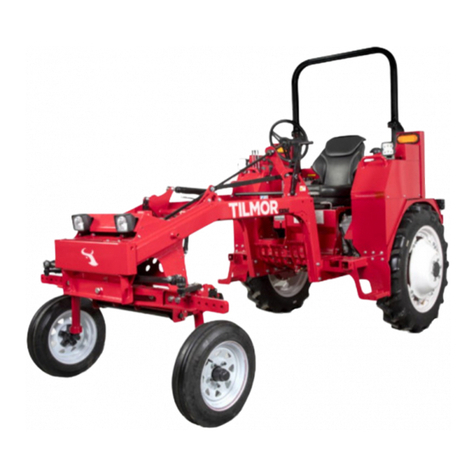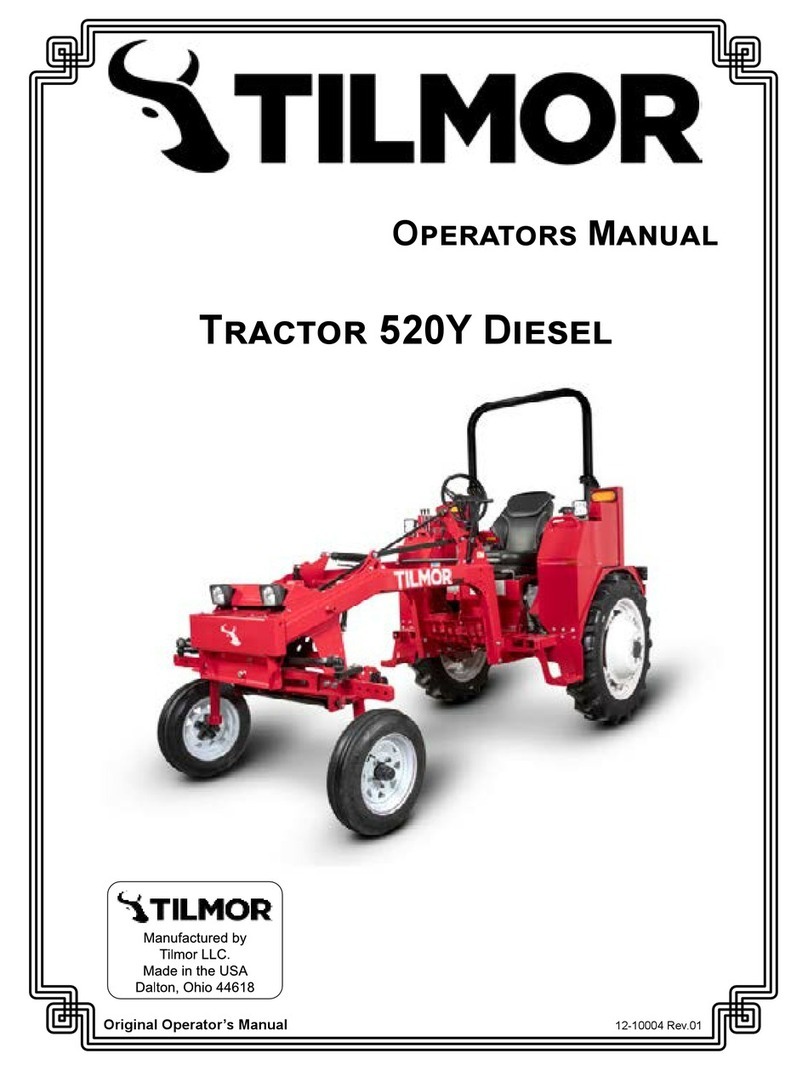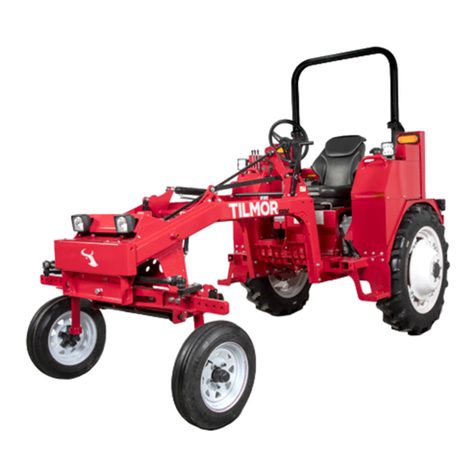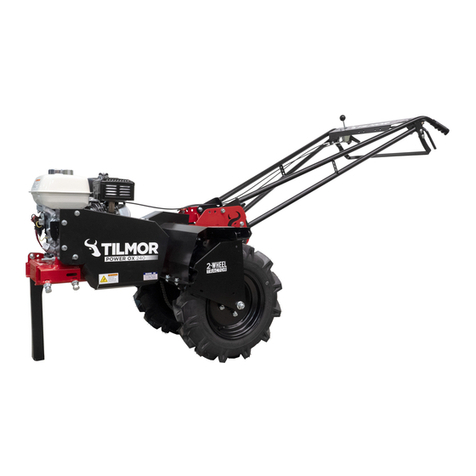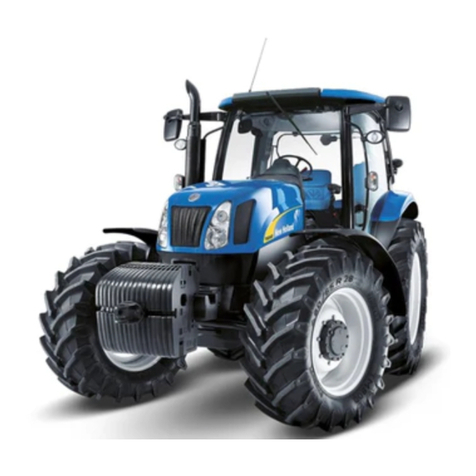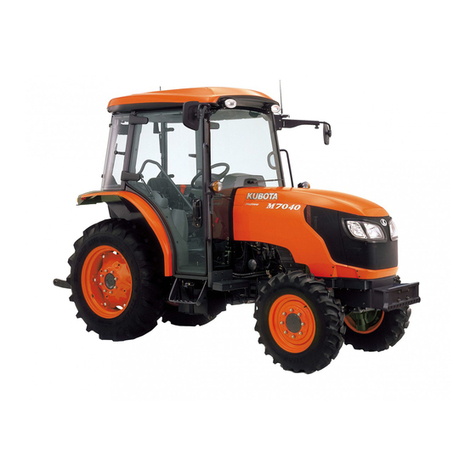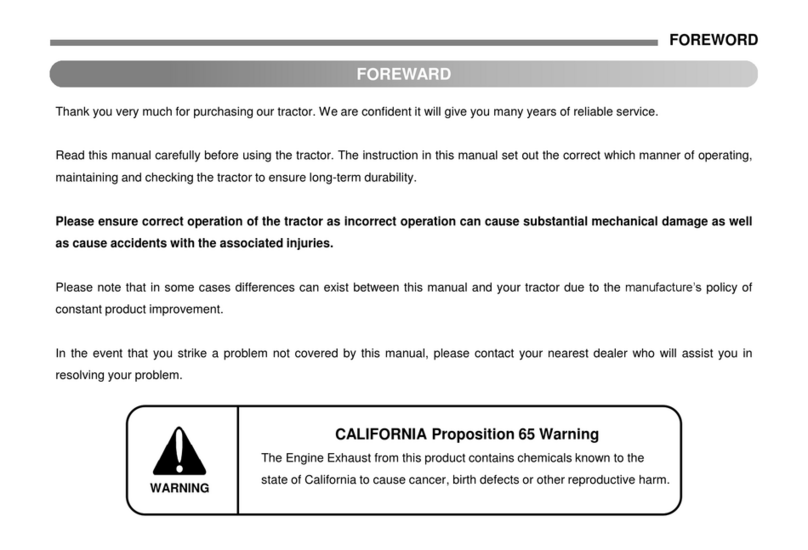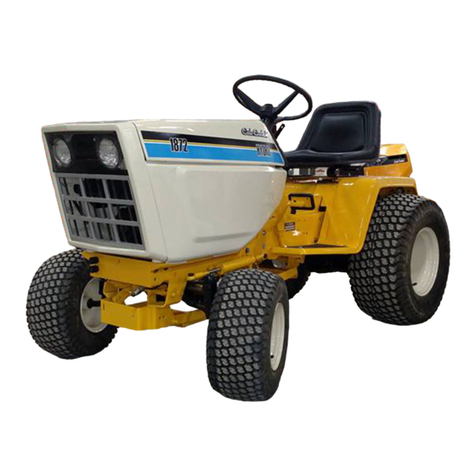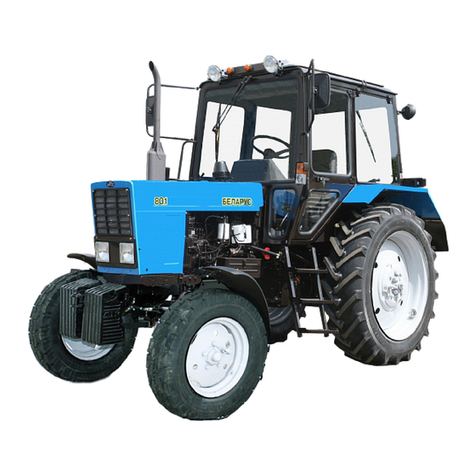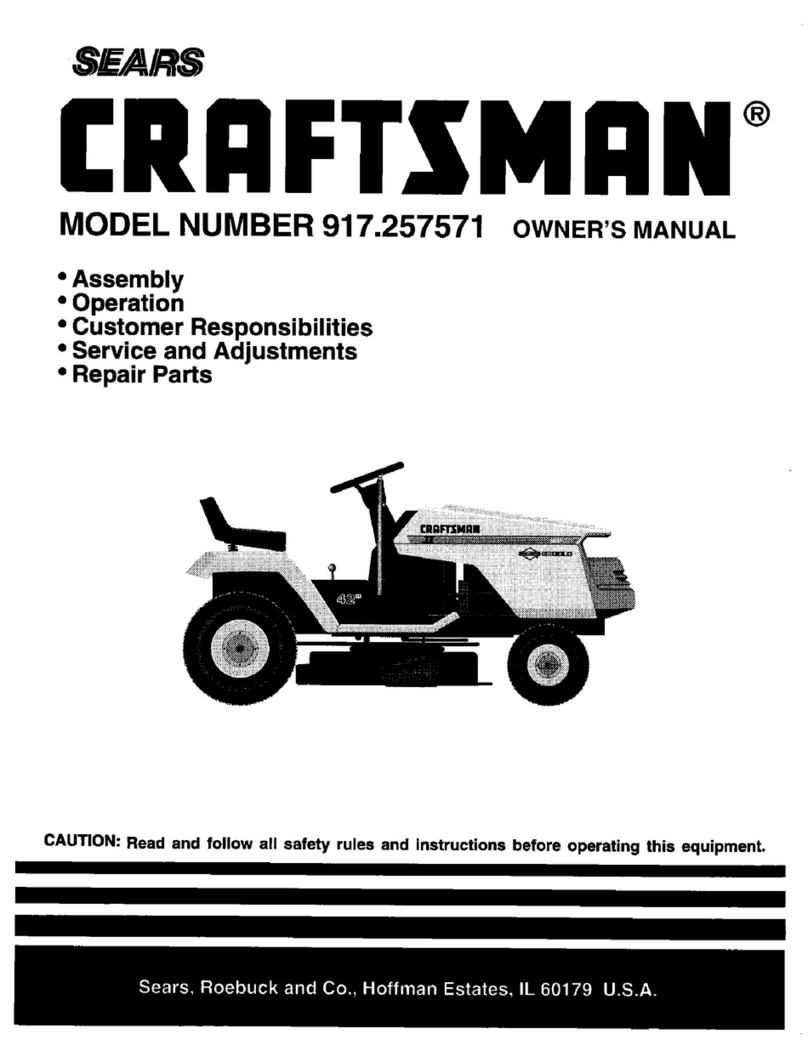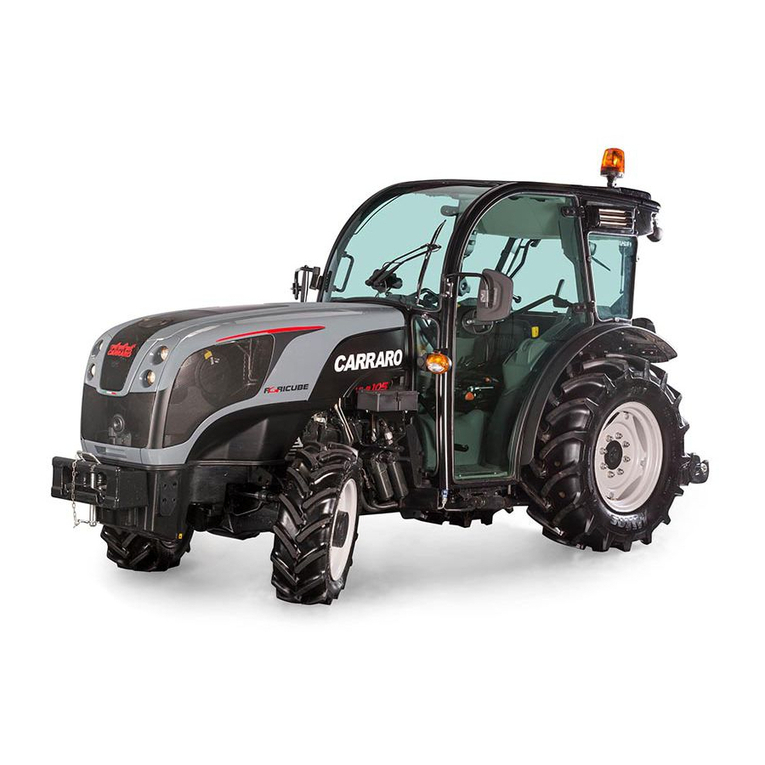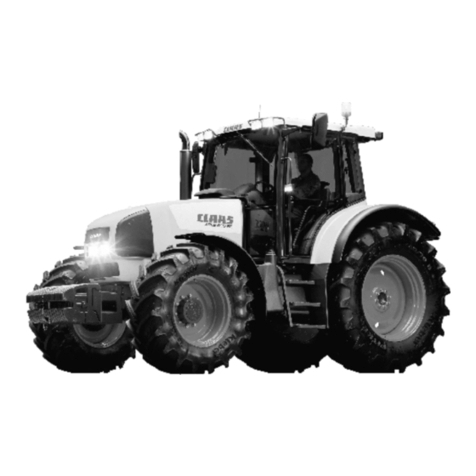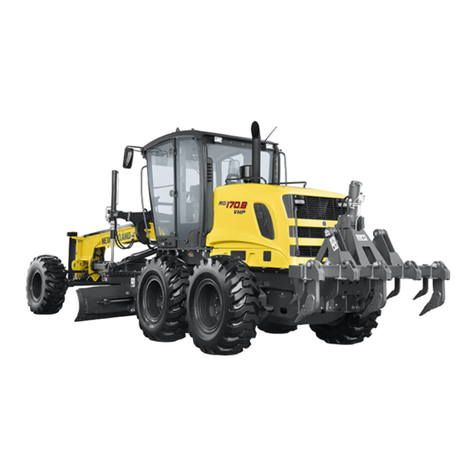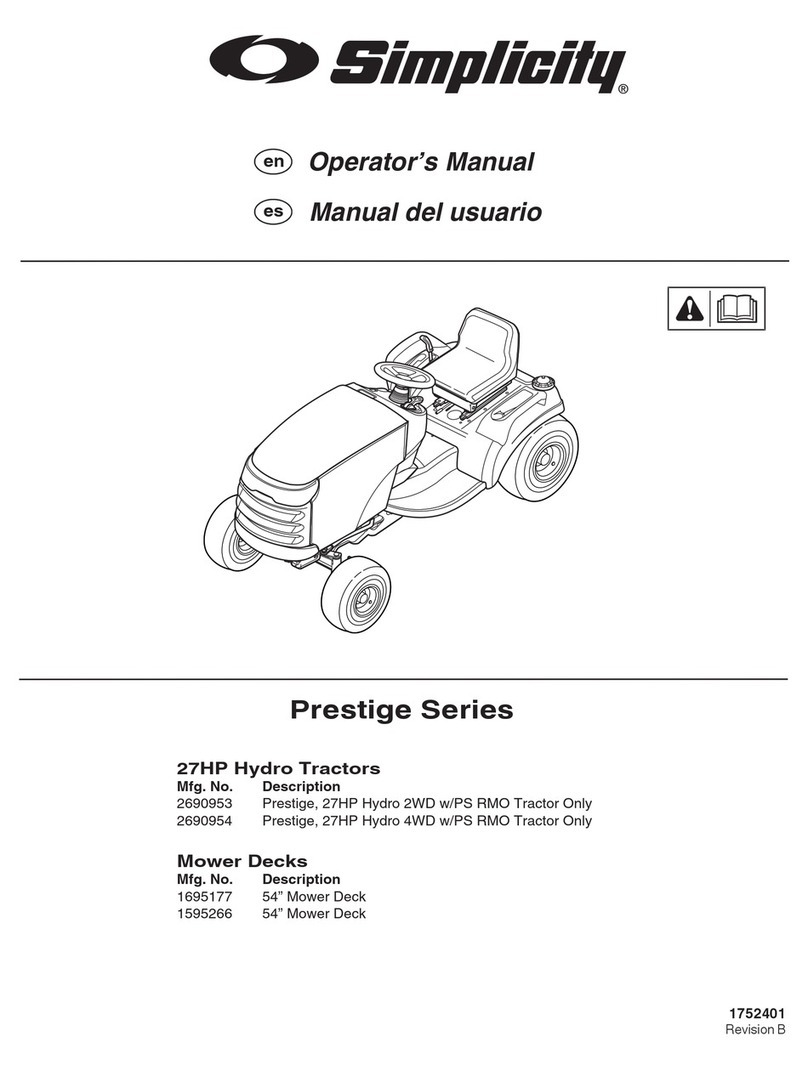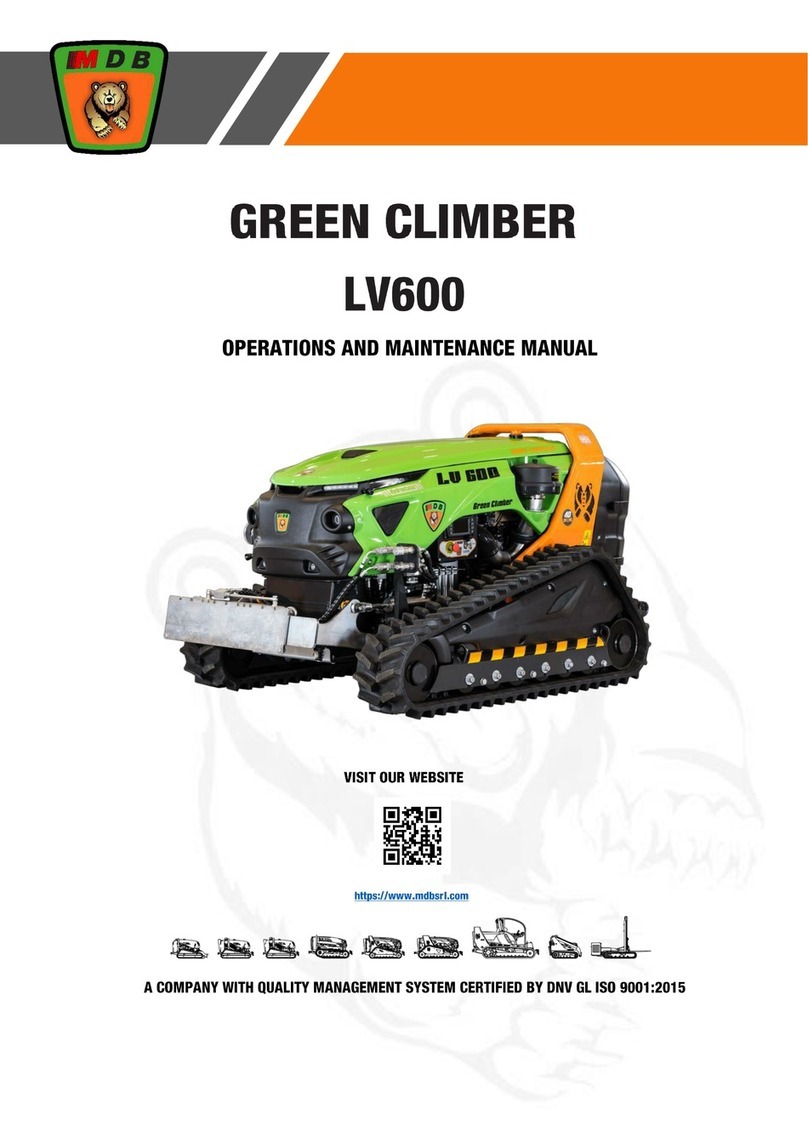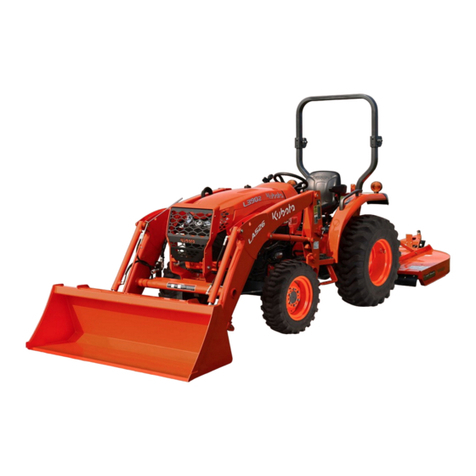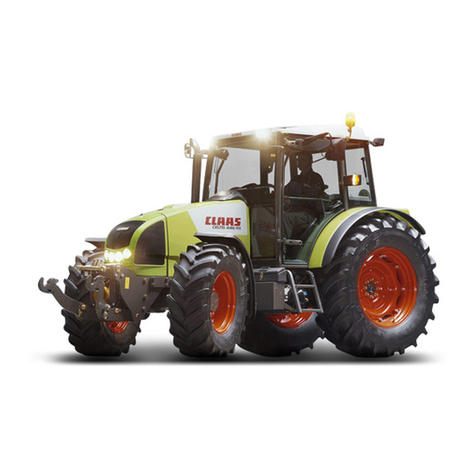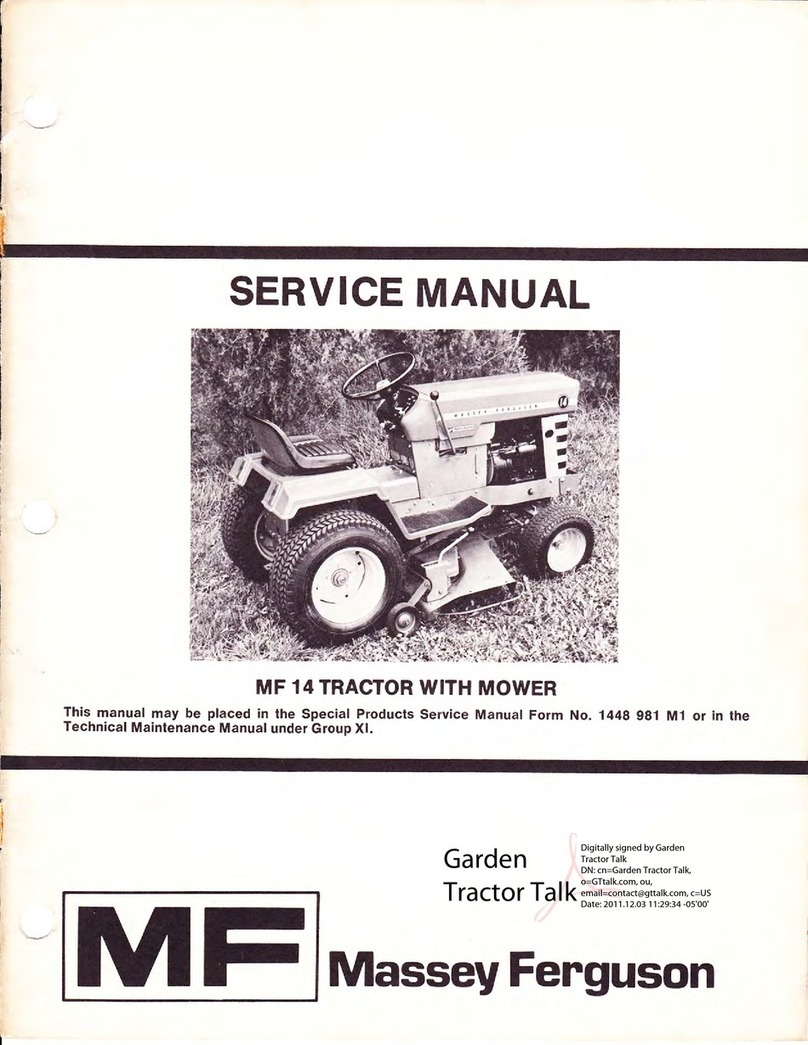TILMOR Power Ox 220A User manual

12-10003 Rev.02

TABLE OF CONTENTS
Product Description................................................................................................................................4
Using Your Manual.................................................................................................................................5
Safety Decals .........................................................................................................................................6
Training Required...................................................................................................................................8
Personal Protective Equipment Requirements ......................................................................................8
Operation Safety ....................................................................................................................................8
Preventing Accidents..............................................................................................................................9
Keep Riders O......................................................................................................................................9
Truck or Trailer Transport.......................................................................................................................9
Maintenance...........................................................................................................................................9
Fuel Safety...........................................................................................................................................10
Power Ox 220A Tractor Safety Procedures ......................................................................................... 11
Standard Operational Controls.............................................................................................................12
Handlebar Adjustment..........................................................................................................................13
Receiver Hitch Use ..............................................................................................................................14
Daily Inspection....................................................................................................................................15
Operating Procedure............................................................................................................................15
Starting the Engine...............................................................................................................................16
Stopping the Engine.............................................................................................................................16
Storage.................................................................................................................................................16
Service and General Maintenance.......................................................................................................17
Cleaning and Appearance Care ...........................................................................................................17
Engine Servicing ..................................................................................................................................17
Belt Inspection......................................................................................................................................18
Belt Replacement Narrow Frame Unit .................................................................................................18
Belt Replacement Wide Frame Unit.....................................................................................................20
Lubrication Locations ...........................................................................................................................22
Chain Tension Adjustment....................................................................................................................22
Drive Control Linkage Adjustment........................................................................................................23

TABLE OF CONTENTS
Engine..................................................................................................................................................24
Belt .......................................................................................................................................................24
Narrow Tires.........................................................................................................................................24
Wide Tires ............................................................................................................................................24
Drive Chains.........................................................................................................................................24
Fluid Capacities & Specications.........................................................................................................24
Dimensions Wide Tire Conguration....................................................................................................25
Dimensions Narrow Tire Conguration ................................................................................................26
Features...............................................................................................................................................27
Return Policy & Procedure...................................................................................................................28
Warranty...............................................................................................................................................28
Non-serialized Product - 1 Year ...........................................................................................................28
Serialized Product - 2 Year or 1000 hours ...........................................................................................28
Tilmor Warranty Policy .........................................................................................................................28
Tilmor Warranty Procedure ..................................................................................................................28

INTRODUCTION
The Power Ox 220A Two Wheel Tractor Is designed for planting, cultivation, and light hilling. The Power Ox
220A is powered by a Briggs and Stratton 550 series engine with 6:1 gear reduction. It is a well balanced
machine with 11” + of ground clearance. The handle bar height is adjustable, making the tractor easy to
use and comfortable for the operator. The Power Ox 220A is available in multiple congurations: Narrow
frame with skinny tires designed for 15” row crop cultivation. Narrow frame with fat tires designed for more
otation in sandier soils on 18-20” rows. The wide frame conguration gives 36” between the tires and is
designed to straddle a 30” bed and bed shoulder.
This manual has been created to help you gain the important knowledge of what is needed to safely
operate, maintain, and service your machine. It is divided into sections for convenient reference of the
appropriate section.
You must read and understand the operator’s manual for each piece of Tilmor equipment you own. Read-
ing the operator’s manual will help you become familiar with each specic piece of equipment. Under-
standing the operator’s manual will help you, as well as others, avoid personal injury and/or damage to the
equipment. Keep this manual with the machine at all times. The manual should remain with the machine
even if it is sold. If this manual becomes damaged or unreadable, it should be replaced immediately. This
manual is available on our website at www.tilmor.com
When using a Tilmor attachment, be sure to read and follow the safety and operating instructions of both
the power unit and the attachment being used to ensure the safest operation possible.
The information in this manual provides the operator with the safest procedures to operate the machine
while getting the maximum use out of the unit. Failure to follow the safety precautions listed in this manual
may result in personal injury and/or damage to the equipment.
Tilmor LLC. is pleased to provide you with your new Tilmor
Power Ox 220A!
Please visit our website, www.tilmor.com for a complete list of
available Tilmor products, and resources.

INTRODUCTION
Throughout this manual, you will encounter special messages and symbols that identify potential safety
concerns to help you as well as others avoid personal injury or damage to the equipment.
This symbol identies potential health and
safety hazards. It marks safety precautions.
Your safety and the safety of others is involved.
There are three signal words that describe the level of safety concern: Danger, Warning, and Caution.
Safety should always be the #1 priority when working on or operating equipment. Accidents are more likely
to occur when proper operating procedures are not followed or inexperienced operators are involved.
Note: Right-Hand and Left-Hand orientations may be referred to at dierent places throughout this manual.
Right-Hand and Left-Hand is determined as if facing forward from the operator station.
WARNING
Indicates a potentially hazardous situation
which, if not avoided, could result in death or
serious injury.
DANGER
Indicates an imminently hazardous situation
which, if not avoided, will result in death or
serious injury. This signal word is limited to
the most extreme cases.
CAUTION
Indicates a potentially hazardous situation
which, if not avoided, may result in minor or
moderate injury and/or property damage. It may
also be used to alert against unsafe practices.
A Tilmor tractor or other Tilmor engine powered device that may be operated by itself or with
an attachment or accessory.
A piece of Tilmor equipment that requires a Power Unit for operation.
A device that attaches to a Power Unit or Attachment to extend its capabilities.
Describes any “Attachment” or “Accessory” that is used in conjunction with a power unit.

The following safety decals must be maintained on your Tilmor Power Ox 220A. Keep all safety decals
legible. Remove all grease, dirt, and debris from safety decals and instructional labels. If any decals are
faded, illegible, or missing, visit www.tilmor.com or call 1-844-255-5864 for replacements. When replace-
ment or new components are installed, be sure that current safety decals are axed to the replacement or
new part.
AA
AAAA
EE
DDDD
BBCC

SAFETY
A Warning, Moving Parts 00-0216 3
B Warning - Read Owners Manual 00-0217 1
C Warning - General Safety 00-0220 1
D Warning - Pinch Point 00-0218 2
E Danger Shield Missing 00-0492 1
AABB
CCDD
EE

SAFETY
• The owner of this machine is solely responsible for properly training the operators.
• The owner/operator is solely responsible for the operation of this machine and prevention of accidents
or injuries occurring to him/herself, other people, or property.
• Do not allow operation or service by children or untrained personnel.
Local regulations may restrict the age of the operator.
• Before operating this machine, read the operator’s manual and under-
stand it’s contents.
• If the operator of the machine cannot understand this manual, then it
is the responsibility of this machine’s owner to fully explain the material
within this manual to the operator.
• Learn and understand the use of all of the controls.
• Know how to stop the power unit and all attachments quickly in the
event of an emergency.
It is the responsibility of the owner to be sure that the operators use the proper personal protective equip-
ment while operating the machine. Required personal protective equipment includes but is not limited to
the following list.
• Wear a certied ear protection device to prevent the loss of hearing.
• Prevent eye injury by wearing safety glasses while operating the machine.
• Closed toe shoes must be worn at all times.
• Long pants must be worn at all times.
• When operating in dusty conditions, it is recommended that a dust mask be worn.
• Inspect all equipment before operation. Repair or replace any damaged, worn, or missing parts. Be
sure all guards and shields are in proper working condition and are secured in place. Make all of the
necessary adjustments before operating the machine.
• Some pictures in this manual may show shields or covers opened or removed in order to clearly illus-
trate any instructions. Under no circumstance should the machine be operated without these devices
in place.
• Alterations or modications to this machine can reduce safety and could cause damage to the
machine. Do not alter safety devices or operate with shields or covers removed.
• Before each use, verify that all controls function properly and inspect all safety devices. Do not oper-
ate if controls or safety devices are not in proper working condition.
• Observe and follow all safety decals.
• Ensure all attachments or accessories are locked or fastened securely before operation.
• Ensure that all bystanders are clear of the machine before operation. Stop the machine if someone
enters your work area.
• Always be alert to what is happening around you, but do not lose focus to the task you are perform-
ing. Always look in the direction the machine is moving.
• If you hit an object, stop and inspect the machine. Make all necessary repairs before continuing
operation of the machine.
• Stop operation immediately at any sign of equipment failure. An unusual noise can be a warning of
equipment failure or a sign that maintenance may be required. Make all necessary repairs before
continuing operation of the machine again.
• Do not leave the machine unattended while it is running.
• Always park the machine on level ground.
• Always shut o the engine when connecting the attachments to the power unit.

SAFETY
• Never leave equipment unattended without shutting o the engine.
• Only operate in well-lit conditions.
• Do not operate when there is a risk of lightning.
• Do not run the engine in a building without adequate ventilation.
• Do not touch the engine or the muer while the engine is running or immediately after stopping the
engine. These areas may be hot enough to cause a burn.
• Do not change the engine governor settings or over-speed the engine. Operating the engine at
excessive speed may increase the hazard of personal injury.
• To reduce the hazard of re, keep the engine, and muer areas free of grass, leaves, excessive
grease, and other ammable materials.
• Clear working area of objects that might be hit or thrown from the machine.
• Keep people and pets out of working areas.
• Know the work area well before operation. Do not operate where traction or
stability is questionable.
• Reduce speed when you are operating over rough ground.
• Equipment can cause serious injury
and or death when improperly used.
• Before operating understand the
operation and safety of the power unit
and attachment being used.
• Do not operate the machine if you are not in good physi-
cal and mental health, if you will be distracted by personal
devices, or are under the inuence of any substance that
may impair decision, dexterity, or judgement.
• Children are attracted to machine activity. Be aware of children and do not allow them in the working
area. Turn o the machine if a child enters the work area.
• The tractor is not designed to have riders of any kind on the tractor, attachments, or attached tools.
• Use full width ramps for loading the machine into a truck or trailer.
• Always secure the power unit and/or attachment to the transporting vehicle securely using straps ,
chains, cable, or ropes.
• Both front and rear straps should be directed down and outward from the machine.
• Shut o fuel supply to the power unit during transport on a truck or trailer.
• Keep all safety decals legible. Remove all grease dirt, and debris from safety decals and instruc-
tional labels.
• If any decals are faded, illegible, or missing, visit www.tilmor.com.
• When new components are installed, be sure that current safety decals are axed to the replacement
components.
• If any component requires replacement use only original Tilmor replacement parts.
• Keep all bolts, nuts screws and other fasteners properly tightened.
• Always ensure the kickstand is lowered or the power unit is supported, and shut o engine. Make
sure all moving parts have come to a complete stop before cleaning, inspecting, adjusting, or repair-
ing.

SAFETY
• Never perform maintenance on the power unit and/or implement if someone is in the operator’s station.
• To reduce the hazard of re, keep the engine and muer areas free of grass, leaves and excessive grease.
• Do not touch the engine, the muer, or other exhaust components while the engine is running or
immediately after stopping the engine. These areas may be hot enough to cause a burn.
• Allow the engine to cool before storing and do not store near an open ame.
• Do not change the engine governor settings or over-speed the engine. Operating engine at excessive
speed may increase the hazard of personal injury.
• Springs may contain stored energy. Use caution when disengaging or removing springs and/or spring
loaded components.
• An obstruction or blockage in a drive system or moving/rotating parts may cause a build up of stored
energy. When the obstruction or blockage is removed, the drive system or moving/rotating parts may
move suddenly. Do not attempt to remove an obstruction or blockage with your hands. Keep hands,
feet, and clothing away from all power driven parts.
• Dispose of all uids in accordance with local laws.
• To avoid personal injury or property damage, use extreme care in handling gasoline. Gasoline is
extremely ammable and the vapors are explosive.
• Do not refuel the machine while smoking or at a location near ames or sparks.
• Always refuel the machine outdoors.
• Do not store the machine or fuel container indoors where the fuel or fumes can reach an open ame,
spark, or pilot light.
• Only store fuel in an approved container. Keep out of reach of children.
• Never ll containers inside a vehicle or on a truck or trailer bed with a plastic liner. Always place con-
tainers on the ground away from your vehicle before lling.
• Remove the machine from the truck or trailer and refuel it on the ground. If this is not possible, refuel
the machine using a portable container, rather than from a fuel dispenser nozzle.
• Never remove the fuel cap or add fuel with the engine running. Allow the engine to cool before refueling.
• Never remove the fuel cap while on a slope. Only remove when parked on a level surface.
• Replace all fuel tank and container caps securely.
• Do not overll the fuel tank. Overlling of the fuel tank could result in engine ooding, fuel leakage
from the tank, or damage to the emissions control system.
• If fuel is spilled, do not attempt to start the engine. Move the power unit away from the fuel spill and
avoid creating any source of ignition until fuel vapors have dissipated.
• If the fuel tank must be drained, it should be drained outdoors into an approved container.
• Dispose of all uids in accordance with local laws.
• The fuel system is equipped with a shut-o valve. Shut o the fuel when transporting the machine to
and from the job, when parking the machine indoors, or when servicing the fuel system.

SAFETY
• Do not remove any safety guards.
• Do not operate the Power Ox 220A without all shields properly installed.
• Do not operate the Power Ox 220A without a tool installed in the receiver hitch.
• Moving parts can cause injuries. Keep hands and feet clear of moving parts.
• Pinch points: some parts can pinch or crush. Keep clear of pinch points and use caution during opera-
tion of the Power Ox 220A.
• Clear the area of all obstacles, hazards, and personnel before operating the Power Ox 220A.
• Do not modify the Power Ox 220A in any way. Modifying the Power Ox 220A could cause injury or
damage to equipment. Any modication made to the Power Ox 220A will void any warranty.
WARNING
Operating, servicing and maintaining o-road
equipment can expose you to chemicals including
engine exhaust, carbon monoxide, phthalates, and
lead, which are known to the State of California to
cause cancer and birth defects or other reproduc-
tive harm. To minimize exposure, avoid breathing
exhaust, do not idle the engine except as neces-
sary, service equipment in a well-ventilated area
and wear gloves or wash your hands frequently
when servicing equipment.
For more information go to
www.P65Warnings.ca.gov.

Use the following images to help identify the loca-
tions of operational controls. The letter next to each
control can be referenced to the list that follows
these images.
BB
CC
DD
EE
GG
AA
FF
JJ
HH
II
A. Drive Control Handles
B. Throttle Control
C. Choke
D. Fuel Shuto
E. Stop Switch
F. Starter Cord Handle
G. Handle Height Adjustment Knob
H. Handle Height Adjustment Mechanism
I. Receiver Hitch
J. Drive Control Handle Guard

GENERAL OPERATION
The Power Ox 220A has a height adjustable handle-
bar to increase operator control and comfort. The
following steps describe how to adjust the handle-
bars.
1.
CAUTION
After adjusting the handlebars it may be neces-
sary to adjust the drive control linkage. Failure to
adjust the drive control linkage could result in over
tightening of the drive control linkage will prevent
the belt tensioner from disengaging, resulting in
tractor movement on startup. Bodily injury or dam-
age to equipment may occur.
Loosen the handlebar adjustment knob (A).
2.
AA
Pull the adjustment mechanism (B) toward the
engine to disengage the mechanism from the
notches.
3.
BB
Raise or lower the handlebars to the desired
height.
4. Push the adjustment mechanism (B) away from
the engine to engage the notches. Ensure that
the mechanism is fully seated in the notches.
5.
BB
Tighten the adjustment knob (A) to secure the
handle bars and adjustment mechanism in
place.
6.
AA
Adjust the drive control linkage as required, in
accordance with the drive control linkage adjust-
ment procedure in this manual.

GENERAL OPERATION
The Power Ox 220A has an adjustable receiver
hitch to easily connect and disconnect tools. The fol-
lowing steps describe how the receiver hitch can be
installed based on the height of the tool or increased
ground clearance.
1.
WARNING
Always shut o power unit engine, and ensure
all moving parts have come to a complete stop
before adjusting the hitch, installing, or removing
an implement.
Install the hitch in the standard elevated position
(A) for increased ground clearance.
2.
AA
The hitch can be installed in the lower position
(B) if needed by simply ipping the receiver over.
BB
3. In both congurations the hitch receiver is
secured in position using a 5/8” hitch pin (C)
placed through the frame secured in place with
a hair pin placed through the bottom of the hitch
pin. Tighten the 3/8” bolt (D) to hold the hitch
receiver steady.
4.
CC
DD
The connected tool is held in place using a 3/4”
hitch pin (E) secured in place with a hair pin
placed through the bottom of the hitch pin.
EE

GENERAL OPERATION
1.
WARNING
Always shut o power unit engine, and ensure
all moving parts have come to a complete stop
before inspecting components, or attempting any
repair or adjustment.
Park the power unit on a level surface, with the
engine shut o and all uids cold.
2. Refer to the power unit engine operator’s
manual. Check the power unit’s engine oil level,
clean the area around the muer and controls,
and clean the nger guard. Add uid or service
as required.
3. Perform a visual inspection of the tractor and
any attachments. Look for loose or missing
hardware, damaged components, or signs of
wear.
4. Grease the two drive axle ange bearings
before each use.
5. Apply a penetrating lubricant to the chain and
upper sprockets.
NOTE: The sprocket guards may need to be
removed to properly lubricate the sprockets. Re-
install the sprocket guards before operating the
tractor.
6. Check the tire pressure. Ensure that each tire
is inated to the pressure marked on the tire.
7. Apply a rust preventative lubricant to the
exposed section of the drive shaft as needed.
8. Check the drive chain tension on both wheels.
Before operating the power unit for the rst time,
please review the Safety and Operational Controls
sections in this manual.
1.
WARNING
Before Operating the Power Ox 220A for the rst
time, ensure that the engine has had oil added in
accordance with the Briggs and Stratton operators
manual. Failure to do so could result in damage to
the engine.
Perform the daily inspection procedure to con-
rm that the power unit is in good operating
condition.
2. Adjust the handlebars to the desired height.
Ensure that the handle bar adjustment mecha-
nism is locked in position and the adjustment
knob is tightened securely.
3.
Do not operate the tractor without a tool installed
in the receiver hitch.
Install the desired tool to the tractor hitch.
Ensure that the hitch pin is fully installed and
secured in place with the hair pin.
4. Start the engine in accordance with the starting
the engine procedure in this manual.
5. Engage the drive system and begin forward
movement. Firmly grasp the handle bar with one
hand. Using the other hand slowly apply upward
pressure to the drive control handle towards the
handlebar grip.
6. To stop forward movement release the drive
control handle.

GENERAL OPERATION
1.
WARNING
Before Starting the Power Ox 220A for the rst
time, ensure that the engine has had oil added in
accordance with the Briggs and Stratton operators
manual. Failure to do so could result in damage to
the engine.
CAUTION
Do not use ether or starting uids. Use of starting
uids in the air intake system may be potentially
explosive or cause a runaway engine condition.
Use of starting uids could result in engine dam-
age and/or personal injury.
Ensure that the power unit is parked on a level
surface.
2. Ensure that a tool or implement is installed in
the hitch receiver.
3. Ensure that the drive control handles are disengaged.
4. Move the fuel shuto lever (A) to the on position.
5.
AA
BB
Move the choke control lever (B) to the choke
position.
Choke is usually unnecessary when restart-
ing a warm engine.
6. Move the throttle control lever to the fast position.
7. Move the stop switch to the ‘ON’ position.
WARNING
Rapid retraction of the starter cord (kickback) will
pull your hand and arm toward the engine causing
injury to the operator. When starting the engine,
pull the starter cord slowly until resistance is felt
and then pull rapidly to avoid kickback.
8. Firmly hold the starter cord handle. Pull the
starter cord handle slowly until resistance is felt,
then pull rapidly.
9. Move the choke to the o position.
1. Move the stop switch to the stop position, or
move the throttle control lever to the slow posi-
tion and the stop switch to the stop position.
2. Move the fuel shuto lever to the o position.
1.
CAUTION
Do not use high pressure water to clean the trac-
tor. High pressure water can force its way into
bearings and other components causing damage
to equipment.
Clean or wash the power ox to remove any accu-
mulated dirt and debris.
2. Apply a rust preventative lubricant to the
exposed section of the drive shaft. The drive
shaft is bare steel and if exposed to moisture
could rust.
3.
Fuel can become stale when stored over 30 days.
Stale fuel causes acid and gum deposits to form
in the fuel system or on essential carburetor parts.
Use a fuel stabilizer. The recommended fuel
stabilizer is Briggs & Stratton FRESH START
fuel stabilizer.
4. Change the oil in accordance with the Briggs &
Stratton operators manual.
1. Perform a visual inspection of the power ox.
Look for loose or missing hardware, damaged
components, or signs of wear.
2.
If any component requires replacement, use only
original Tilmor replacement parts.
Grease and lubricate the lubrication locations
identied in the service section of this manual.
3. Check the tire pressure. Ensure that each tire
is inated to the pressure marked on the tire.

If any component requires replacement, use only
original Tilmor replacement parts.
WARNING
Always shut o power unit engine, and ensure
all moving parts have come to a complete stop
before inspecting components or attempting any
repair or adjustment.
Proper and timely service of the Power Ox 220A is
critical to keep the tractor in safe and reliable oper-
ating condition.
For best results, and to maintain the nish of the
power unit, clean or wash the power unit.
To maintain the nish of the Power Ox 220A,
thoroughly wash the equipment after each use to
remove any corrosive agents. Failure to clean the
equipment may result in corrosion of (including
but not limited to) steel, and aluminium.
CAUTION
If the engine has been running, it must be allowed
to cool in order to prevent damage to the block
and exhaust manifold.
Do not use high pressure water to clean the trac-
tor. High pressure water can force its way into
bearings and other components causing damage
to equipment.
Allow the power unit and all components to cool
before washing. Refer to the specic service section
for proper cleaning techniques for the engine and
engine compartment. Use mild soap and water to
clean the power unit. Harsh chemical cleaners could
cause damage to the nish or the components.
All engine servicing is to be completed in accor-
dance with the Briggs & Stratton operators manual.
The engine service intervals are listed below.
• Change engine oil.
• Check engine oil level.
• Clean area around muer and controls.
• Clean nger guard.
• Clean air lter*.
• Clean pre-cleaner*.
• Change engine oil.
• Inspect the muer and spark arrester.
• Change gear reduction oil (if equipped).
• Replace air lter.
• Replace pre-cleaner.
• Replace spark plug.
• Clean air cooling system*.
* In dusty conditions or when airborne debris is
present, clean more often.

Inspecting the drive belt of the Power Ox 220A can
prevent sudden belt failure by nding problems
before they can cause a belt to break.
Typical wear
on a drive
belt may
result in the
conditions
shown in the
diagram. If
any of these
conditions
occur, the drive belt will require replacement. To
perform the belt inspection the following steps are
provided.
1. Remove the belt and pulley cover by removing
the ve 5/16” hex bolts and washers (A) that
secure the cover to the upper and lower cover
mounts.
2.
AA
The belt can then be freely rotated by hand over
the pulleys.
3. After the belt has been thoroughly inspected
ensure that the belt is positioned over the pul-
leys as shown below.
4. Position the belt and pulley cover over the belt
and pulleys and align the mounting holes.
5. Install the ve 5/16” hex bolts and washers (A).
6. Torque the ve bolts to 210 in-lbs (24 Nm).
At some point it will be necessary to replace a worn
belt. The following steps describe the process.
1.
CAUTION
Ensure that the Power Ox 220A is securely sup-
ported. Failure to properly support the unit could
result in damage to equipment or injury.
Support the unit with jack stands or another
secure method, so that the left side wheel is o
the ground.
2. With the unit securely supported, remove the
belt and pulley cover by removing the ve 5/16”
bolts and washers (A).
3.
AA
Remove the lower frame tube (B) by removing
the eight 3/8” carriage bolts and lock nuts that
secure it to the frame and fenders.
BB

4. Remove the two 3/8” carriage bolts and locknuts
(C) that secure the left fender assembly to the
upper frame tube. Removing the bolts allows the
fender assembly to rotate freely on the axle.
5.
CC
The belt can now be removed from the pulleys and
routed over the fender assembly as shown below.
6. Route the new belt under the tire and over the
fender assembly.
7. Install the new belt over the pulleys as shown.
8. Install the two 3/8” carriage bolts and locknuts
(D) through the upper frame tube and fender.
9.
DD
Torque the bolts to 31 ft-lbs (42 Nm).
10. Install the lower front frame tube. Install all eight
3/8” carriage bolts and lock nuts hand tight.
11. Torque the bolts to 31 ft-lbs (42 Nm) alternating
between all of the bolts until the torque is reached.
12. Install the belt and pulley cover using the ve
5/16” bolts and washers (E).
EE
Torque the bolts to
210 in-lbs (24Nm).

SERVICE
1. Remove the belt and pulley cover by removing
the ve 5/16” bolts and washers (A).
2.
AA
Remove the sprocket cover by removing the two
3/8” carriage bolts and nuts (B).
3.
BB
Loosen the two set screws (C) in the left shaft
free wheel bushing using a 3mm hex key.
CC
4. Loosen the two set screws (D) in the left outer
ange bearing using a 1/8” hex key.
5.
DD
Loosen the two set screws (E) from the left axle
shaft coupler using a 5/32” hex key.
6.
EE
Slide the axle shaft coupler onto the half shaft
as shown below and remove the key (F).
7.
FF
Slide the axle half shaft (G) through the ange
bearing to allow the belt to pass between the axles.
GG
Table of contents
Other TILMOR Tractor manuals
